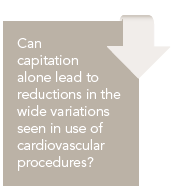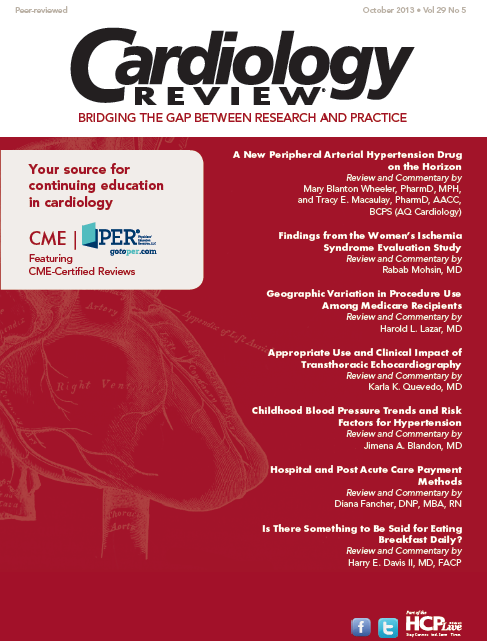Geographic Variation in Procedure Use Among Medicare Recipients
The wide variation in geographic utilization of coronary angiography, percutaneous coronary intervention (PCI), and coronary artery bypass graft (CABG) surgery, despite reimbursement structure, suggests that capitation alone may not lead to reductions in variation.

Harold L. Lazar, MD
Review

Matlock DD, Groeneveld PW, Sidney S, et al. Geographic variation in cardiovascular procedure use among Medicare fee-for-service vs Medicare Advantage beneficiaries. JAMA. 2013;310:155-162.
Study Details
In their review, Matlock and coauthors compared the rates of coronary angiography, percutaneous coronary intervention (PCI), and coronary artery bypass graft (CABG) surgery between Medicare Advantage and Medicare Fee-for-Service (FFS) reimbursement structures across 32 referral regions in 12 states.
In the Medicare FFS reimbursement system, physicians are paid more for doing more procedures. In the Medicare Advantage system, payments are capitated and the physicians in this structure are not paid more for doing more procedures. The authors hypothesized that overall rates and the degree of geographic variation for these procedures would be lower in the Medicare Advantage program compared with the Medicare FFS system.
The study included 878,339 Medicare Advantage patients and 5,013,650 Medicare FFS patients over a 5-year period from 2003 to 2007. The Medicare FFS patients were drawn from the Medicare enrollment database. Medicare Advantage patients were sampled from the Cardiovascular Research Network, a National Heart, Lung, and Blood Institute—sponsored consortium of 15 health systems.
Medicare Advantage patients had significantly lower rates of diabetes, hyperlipidemia, and prior coronary artery disease. They also had lower procedure rates for angiography and PCI, but similar rates for CABG compared with Medicare FFS patients. There were no differences between Medicare Advantage and Medicare FFS patients in the rates of urgent angiography or PCI. Procedure rates varied widely across regions for both groups. For both angiography and PCI, the variation in regions was due to variations in nonurgent procedures. There was no significant Spearman rank correlation between the groups in the utilization of angiography (r = 0.19, P = 0.29) and more modest correlations for PCI (r = 0.33, P = 0.06) and CABG surgery (r = 0.35, P = 0.05).
Patients enrolled in the capitated Medicare Advantage programs had significantly lower rates of angiography and PCI but not CABG surgery. The degree of geographic variation in the rates of the procedures was significant in both groups. In the Medicare Advantage patients, adjustments for cardiovascular risk factors had no further influence on procedure rates.
The authors acknowledge several limitations of their study, including: (1) they could not assess the degree by which procedures were influenced by patient preferences or appropriateness; (2) the results were not correlated with clinical outcomes; and (3) the influence of smoking habits between the groups was not assessed.
The authors conclude that although the incidence of angiography and PCI were lower in the capitated Medicare Advantage group, the wide variation in geographic utilization of these procedures, despite reimbursement structure, suggests that capitation alone may not lead to reductions in the wide variations seen in use of cardiovascular procedures.
CommentaryRaising More Questions Than Were Answered
In their study, Matlock and colleagues found that patients enrolled in a capitated Medicare reimbursement program had a significant decrease in the incidence of diagnostic catheterization and PCI procedures compared with patients enrolled in a fee-forservice program, but there was no difference in the utilization of CABG surgery between the 2 groups. There was a significant variation in the utilization of all procedures based on geography, but the differences in variation were similar in both payment groups. The authors concluded that capitation alone may not account for geographic differences in the utilization of cardiovascular procedures.
What conclusions can be derived from this study? As with most provocative studies, the authors raise more questions than they have answered. Three major issues need to be addressed: (1) Why were there differences in the incidence of procedures between the capitated and fee-for-service groups? (2) Why did geographic location account for these differences? (3) Why were there no differences in the incidence of CABG surgery among the groups?
The authors noted that with the exception of CABG surgery, the incidence of angiography and PCI was lower in the capitated group. However, for both these interventions, the variations were due to differences in the incidence of nonurgent procedures. This raises the question of whether there were differences in the incidence of these procedures due to underutilization in the capitated systems or overutilization in the fee-for-service system. While the capitated system had a significantly lower incidence of patients with diabetes, hyperlipidemia, and known coronary artery disease, these differences were small. Furthermore, since there was no difference in the incidence of urgent procedures among the groups, it would appear that patients with more unstable disease received equal treatment in both groups. Did the payment system influence the incidence of angiography and PCI in the patients with stable disease? That question cannot be answered from the data presented in this study. However, the more important question is whether the lower incidence of angiography and PCI in the capitated system influenced the cardiovascular outcomes in these patients. To answer that question, the incidence of deaths from cardiac disease, incidence of myocardial infarctions, admissions for acute coronary syndromes, and need for revascularization procedures would need to be known. This lack of clinical outcomes is a major limitation of the study and restricts the conclusions that can be drawn regarding the “appropriateness” of the lower incidence of angiography and PCI in the capitated patients.
Why was there a geographic difference in the utilization of all cardiovascular procedures regardless of the payment? Were these differences due to changes in practice patterns or the access and availability of catheterization facilities and cardiovascular specialists? The widespread institution of clinical guidelines for cardiovascular disease has helped to reduce the variation in both individual and institutional clinical practices. It is hard to believe that with such easy access to these guidelines, as well as the online access to key journal articles, approaches to clinical practice and cardiovascular disease remains regional. Furthermore, the plethora of national meetings for both invasive and noninvasive cardiologists has resulted in a more uniform practice in treatment of coronary artery disease.
However, as pointed out by the authors, the rate of cardiac catheterizations has been associated with a regional supply of cardiac catheterization laboratories.1 This allows for easier access to determine coronary anatomy and ultimately the need for coronary intervention. This would have more of a role in increasing angiography for elective patients with stable coronary syndromes. It would appear from this study that patients who require urgent procedures are not affected by which Medicare plan they were enrolled in. The increased numbers of catheterization laboratories and cardiovascular specialists in more local regions has undoubtedly increased the incidence of these procedures. As noted above, only by knowing the incidence of clinical events can we determine whether these procedures are being over- or underutilized.
Finally, why were there no differences in the incidences of CABG surgery among the groups? Indications for CABG surgery have been more rigorously applied based on strict guidelines endorsed by both cardiology and surgical societies.2 In addition, the cur- rent guidelines call for recommendations for some lesions, such as left main disease, to be made after consultation using the “Heart Team” approach. Large multi-institutional trials have also reported guidelines for the use of CABG versus PCI in patients with signifi- cant 3-vessel disease.3,4 Open reporting of CABG surgery and the use of online STS calculators to determine CABG risk have also helped to regulate the volume of CABG surgery nationally. Further- more, there is now more complete information as to which high- risk groups, such as octogenarians, will benefit most from CABG surgery.5,6 All these factors have contributed to a more rigid set of indications for CABG surgery that supersede payment plans.
How can we use the data derived from this study to reduce the variations seen in cardiovascular procedures? The solution lies in stricter guidelines for cardiac catheterization and the use of PCI to treat ischemic heart disease. While we must remember that the guidelines are subject to various interpretations based on any given clinical scenario, Class I recommendations should be rigorously en- forced. As with any guideline, data are needed to study the clinical outcomes based on these guidelines to make sure that these poten- tially life-threatening interventions are not underutilized.
References
1. Weinnberg DE, Dickens J Jr, Soule DN, et al. The relationship between the supply of cardiac catheterization laboratories, cardiologists and the use of invasive cardiac procedures in northern New England. J Health Serv Res Policy. 1997;2:75-80.
2. Hollis LD, Smith PK, Anderson R, et al. 2011 ACC/AHA Guideline for coronary artery bypass graft surgery. J Am Coll Cardiol. 2011;58:123- 210.
3. Serruys PW, Morice MC, Kappetin AP, et al. Percutaneous coronary intervention vs. coronary artery bypass grafting for severe coronary artery disease. N Engl J Med. 2009;360:961-972.
4. Yan TD, Padang R, Cao C, et al. Drug-eluting stents vs. coronary artery bypass grafting for treatment of coronary artery disease, a metaanalysis of randomized and non-randomized studies. J Thoracic Cardiovasc Surg. 2011;141:1134-1144.
5. Kurlansky PA, Williams DB, Traad EA, et al. Eighteen year follow-up demonstrates prolonged survival and enhanced quality of life for octogenarians after coronary artery bypass grafting. J Thoracic Cardiovasc Surg. 2011;141-394-349.
6. Saxena A, Dinh DT, Yap CH, et al. Critical analysis of early and late outcomes after isolated coronary artery bypass surgery in elderly patients. Ann Thorac Surg. 2011;92:1703-1711.
About the Author
Harold L. Lazar, MD, is Professor of Cardiothoracic Surgery at Boston University School of Medicine and the Boston Medical Center, Boston, MA. He received his MD from Boston University, completed his residency in general surgery at the University of Michigan Medical Center in Ann Arbor, and did his cardiothoracic residency at Columbia-Presbyterian Medical Center in New York, NY. Dr. Lazar has lectured widely and is the author of numerous journal articles and book chapters. He is the Editor-in-Chief of The Journal of Cardiac Surgery.
